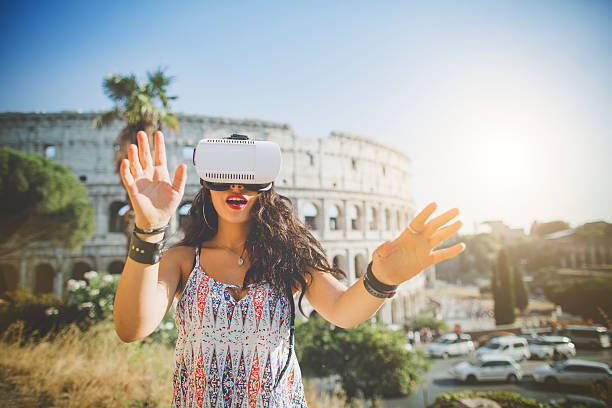
Digital Art and Travel in 2025: Exploring the Intersection of Technology and Culture
The worlds of art and travel have always been intertwined, with travelers seeking out cultural experiences that are as visually and intellectually stimulating as they are immersive. In 2025, technology—specifically digital art, augmented reality (AR), and virtual reality (VR)—is revolutionizing the way we experience both art and culture on our travels. These innovations are not only enhancing traditional art forms but also creating entirely new experiences that are interactive, personalized, and borderless. From AR-enabled cultural tours to immersive VR art exhibitions, the convergence of technology and culture is giving rise to a new era of travel.
1. Digital Art: Changing the Landscape of Cultural Engagement
Digital art is rapidly becoming a dominant force in the global art scene, influencing everything from the way art is created and exhibited to how we interact with it while traveling. Artists are using software, coding, and digital media to create innovative pieces that blur the line between physical and virtual worlds. These works often invite audiences to participate actively, allowing for deeper engagement.
In 2025, digital art exhibitions are being integrated into more and more travel destinations, making art accessible in new and exciting ways. The advantage of digital art in the travel space is its versatility—without the need for physical space, digital art can be projected in a variety of settings, from urban walls to museum galleries, and even on the side of historical monuments.
Destinations Leading the Way:
- Dubai, UAE: Dubai has become a global hub for digital art, with immersive installations at places like the Museum of the Future and the Dubai Digital Art District. Here, visitors can experience art projections on monumental buildings, futuristic 3D displays, and interactive installations that combine art with cutting-edge technology.
- Tokyo, Japan: Japan has long been a leader in technology and art, and in 2025, Tokyo is at the forefront of integrating digital art with cultural experiences. The teamLab Borderless Museum, for example, offers visitors an experience where digital art interacts with the environment, creating a living, breathing exhibition that changes as you move through it.
- Paris, France: The Atelier des Lumières in Paris continues to blend art and technology by showcasing digital art projections of classic artworks. Visitors can walk through massive rooms where the works of Van Gogh or Monet are reimagined in a completely new light, making the experience feel dynamic and contemporary.
2. Augmented Reality (AR): Enhancing Cultural Tours
Augmented reality (AR) technology has taken the travel world by storm, transforming how we engage with historical landmarks, museums, and local culture. With AR, visitors can use their smartphones, tablets, or AR glasses to overlay digital information onto the real world, turning everyday locations into interactive cultural experiences. In 2025, AR is expected to be deeply integrated into cultural tourism, offering an immersive, educational, and engaging way to connect with history, art, and local traditions.
How AR is Changing Cultural Tourism:
- Interactive Historical Sites: AR allows travelers to interact with historical sites in ways previously unimaginable. For example, using AR technology at archaeological sites, visitors might see ancient ruins come to life with virtual reconstructions, giving them a better understanding of how the site looked centuries ago.
- Guided Cultural Tours: AR-based tours are being implemented in cities like Rome, Athens, and Cairo. Travelers can point their phones at landmarks or monuments, and instantly receive detailed information about the location’s history, significance, and cultural context. This immersive experience enriches traditional sightseeing and offers a deeper, more engaging connection to the destination.
Destinations Leading the Way with AR:
- Rome, Italy: AR is bringing the ancient city of Rome to life in unprecedented ways. At sites like the Colosseum and Roman Forum, tourists can use AR apps to view re-creations of gladiatorial battles or the bustling life of ancient Rome, all while walking through these historical sites.
- London, UK: In 2025, London is embracing AR for both art and historical exploration. The British Museum offers an AR experience that brings artifacts to life, while AR-guided walking tours of areas like Covent Garden and Soho add a digital layer of cultural context, allowing visitors to experience the city’s rich history in new ways.
- Cairo, Egypt: The Egyptian Museum and the Pyramids of Giza are utilizing AR to enhance visitors’ understanding of ancient Egyptian culture. AR apps allow travelers to view hieroglyphics, murals, and statues as if they are being animated, offering a deeper exploration of Egypt’s awe-inspiring heritage.
3. Virtual Reality (VR): Immersing Yourself in New Worlds
Virtual reality (VR) has long been used in gaming, but in 2025, it’s increasingly being used to create immersive art experiences and cultural explorations that are perfect for travelers. With VR, the possibilities for experiencing art and history are endless, as it allows users to step into digital worlds that transport them to entirely new places and times.
In art exhibitions, VR enables viewers to step inside an artwork or interact with it in a fully immersive way. For cultural travel, VR allows travelers to experience historical events or places from the past, all from the comfort of their own home or while physically traveling to a destination.
How VR is Transforming Art and Culture in Travel:
- Virtual Museum Tours: Museums around the world are adopting VR to offer virtual tours of their collections. While many museums already offer online tours, VR takes this to the next level by offering fully immersive experiences. Visitors can feel as though they are physically inside the museum, exploring exhibits in 360 degrees.
- Cultural Time Travel: VR offers travelers the chance to experience moments in history firsthand. Imagine witnessing the construction of the Great Wall of China or walking through ancient Pompeii as it existed in 79 AD. VR allows people to travel back in time and experience history like never before.
Destinations Leading the Way with VR:
- Los Angeles, USA: In LA, the The VR Art Museum is revolutionizing the way people view art by showcasing fully immersive virtual exhibitions. Visitors can wear VR headsets and step into digital worlds created by contemporary artists, where they can interact with the art, change its dimensions, and create a truly personalized experience.
- Berlin, Germany: Berlin’s Virtual Reality World offers travelers a chance to explore both the city’s history and cutting-edge digital art. VR tours take visitors on a journey through Berlin’s storied past, including its time as a divided city during the Cold War, while digital art exhibitions immerse participants in the mind of 3D artists who use VR to create stunningly detailed and interactive pieces.
- Venice, Italy: The Venice Biennale has always been a major cultural event, but in 2025, the exhibition will feature VR art installations that allow attendees to experience works from a new, immersive perspective. From experiencing Venice in the past to stepping into the minds of contemporary artists, VR is offering a transformative way to engage with the city’s rich cultural heritage.
4. The Future of Art and Travel: What’s Next?
As digital art, AR, and VR technologies continue to evolve, the future of travel and cultural engagement looks incredibly exciting. By 2025 and beyond, it’s likely that we’ll see even more widespread use of these technologies in both public art installations and cultural experiences.
Here are a few trends to look out for:
- Holographic Art: Artists may begin creating holographic pieces that can be experienced without the need for headsets or special devices, allowing visitors to interact with 3D art in public spaces.
- Personalized Cultural Journeys: With advances in AR, travelers may soon be able to design their own cultural tours, customizing their experiences based on their personal interests—whether that’s ancient history, street art, or modern digital exhibitions.
- Global Collaboration in the Arts: Digital art platforms may allow artists to collaborate in virtual spaces, sharing their work with global audiences regardless of geographical constraints. This could result in truly international cultural festivals or virtual art galleries where travelers can interact with artists in real-time.
A New Age of Travel and Art
In 2025, the intersection of digital art, AR, and VR is reshaping how we experience culture while traveling. Technology has made it possible to interact with art in ways that are dynamic, immersive, and often transformative. Whether you’re walking through the streets of Rome and watching history unfold before your eyes or diving into a digital painting that responds to your every move, the way we connect with culture is forever changed. For travelers seeking new ways to explore the world’s artistic and historical treasures, the future has never looked more exciting.
So, pack your VR headset, download those AR apps, and prepare for a journey where art and technology converge—allowing you to experience culture like never before.
